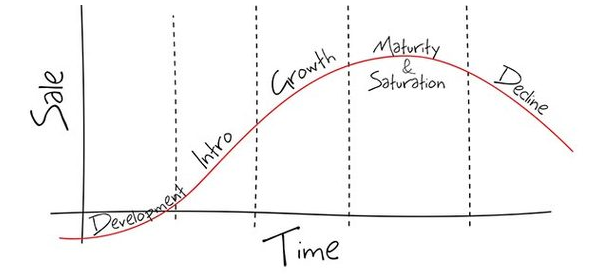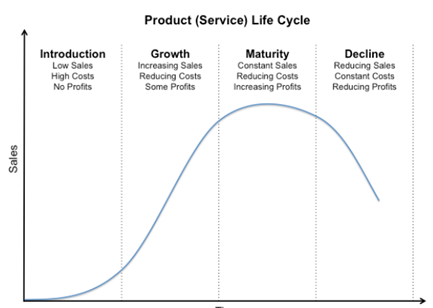Product management is an organizational lifecycle function within a company dealing with the planning, forecasting, and production, or marketing of a product or products at all stages of the product lifecycle.
The role may consist of product development and product marketing, which are different (yet complementary) efforts, with the objective of maximizing sales revenues, market share, and profit margins. Product management also involves elimination decisions. Product elimination begins with the identification of elimination candidates, proceeds with the consideration of remedial actions, continues with a projection of the impact on the business as a whole if a candidate product is eventually eliminated, and concludes with the implementation stage, where management determines the elimination strategy for an item.
Product management is an organizational lifecycle function within a company dealing with the planning, forecasting, and production, or marketing of a product or products at all stages of the product lifecycle.
The role may consist of product development and product marketing, which are different (yet complementary) efforts, with the objective of maximizing sales revenues, market share, and profit margins. Product management also involves elimination decisions. Product elimination begins with the identification of elimination candidates, proceeds with the consideration of remedial actions, continues with a projection of the impact on the business as a whole if a candidate product is eventually eliminated, and concludes with the implementation stage, where management determines the elimination strategy for an item.
Service Management
Service management in the manufacturing context, is integrated into supply chain management as the intersection between the actual sales and the customer point of view. The aim of high performance service management is to optimize the service-intensive supply chains, which are usually more complex than the typical finished-goods supply chain. Most service-intensive supply chains require larger inventories and tighter integration with field service and third parties. They also must accommodate inconsistent and uncertain demand by establishing more advanced information and product flows. Moreover, all processes must be coordinated across numerous service locations with large numbers of parts and multiple levels in the supply chain.
Among typical manufacturers, post-sale services (maintenance, repair and parts) account for less than 20 percent of revenue. But among the most innovative companies in service, those same activities often generate more than 50 percent of the profits.
Have you ever tried to follow the trail of a stick or a pinecone that was placed in a river, watching as it flows away? This is similar to the life cycle of a product or service. The stick or pine cone represents the product or service and the river represents the various places (stages) that the object passes through. Before we delve into just what each stage of the life cycle represents, let’s first define the product life cycle.
The product or service life cycle is a process that follows the different stages that a product or service encounters. The life cycle is broken down into four stages that help to identify where in the market the product or service is at the current time. Let’s take a closer look at the different stages that every new product or service will encounter.
Stages of the Product/Service Lifecycle
From development to decline, each stage of the product/service lifecycle requires different actions. Take a look at the stages below.

- During this stage, you don’t make much money due to high development and marketing costs, even though your price is at its highest. To offset costs and begin bringing in a profit as quickly as possible, invest sufficient funds into a marketing campaign and distribution channels to raise awareness about the new product or service. Additionally, watch the market carefully and experiment with various configurations to determine what works best. Once you notice product demand and sales increasing, you know you’re entering the next lifecycle stage.
- This is the phase in which profits are highest and your cash flow improves. Don’t make the mistake of getting too comfortable, though. You need to continue to make refinements and enhance development capabilities in order to stay ahead of the competition. When you see your sales trend stabilizing, you’re headed to the next stage in the lifecycle.
- During this stage, profits generally decrease, even though sales are stable. This is because prices repeatedly drop in order to compete in the marketplace. That said, sales continue to create sufficient cash flow for your business. It’s crucial during this time to conduct market research, invest in development, and adapt your products and/or services to meet changing consumer needs. Failing to take these actions causes you to be left with products and services that are no longer relevant, and don’t sell.
- While this is the end of the product/service lifecycle, there’s a chance for you to begin the cycle over with your products or services if you’ve taken the appropriate steps during the maturity stage. Invest in a new marketing campaign, address any issues with the product or service, or consider a regeneration strategy (for example, newspapers going from print publications to online publications).
Product Life Cycle
In simple terms, the product life cycle indicates the revenue amount generated by a product over a period of time, right from its inception to its discontinuation. There are five common stages that make up a product cycle. These are
- Development/planning
- Introduction/initiation
- Execution/sales
- Maturity/growth
- Decline
During the introduction phase, sales are usually small since people are just beginning to try your product. It is the growth phase in which sales start to increase and reach their peak during the growth or maturity stage. Finally, there is a decline in the sale of the product owing to market shifts. The discovery of better alternatives could also lead to the decline of a product.
It is important to understand that these stages in a product lifecycle are usually sequential any may overlap.
What is a Service Life Cycle?
A service organization will have to handle a service life cycle as opposed to a product life cycle. What does the management of a service life cycle entail? It is essentially a strategy which offers support to service organizations, helping them realize their gross revenue potential.
The organization may assess various service opportunities as a ‘life cycle’ rather than an independent event or even a set of solitary events. How is this helpful? It is useful in combining each service-based process into a separate, yet complex series of workflows as well as related business processes.
The service life cycle management typically includes these critical elements:
- Administration of workforce
- Planning/forecasting of components
- Organizational asset management
- Knowledge administration
- Reverse logistics
- Management of repair and returns
- Contract management
Service lifecycle management (SLM) software is typically seen as a component of the Product lifecycle management (PLM) software. SLM is helpful in reducing service cost and minimizes preventable return of any faulty products while improving operational efficiency of the service.
Common between Product and Service Life Cycle
While the product life cycle and service life cycle may be managed differently in an organization, they are both determined by the time period for which they can be marketed. For instance, the life cycle of TV CRT (cathode ray tube) has come to an end since a greater number of flat screen TVs are being bought by people today. Similarly, the era of VoIP (voice-over internet protocol) telephone services is now in its growth phase with more and more people showing an inclination to try it out. Hence, the service life cycle of traditional phone lines is slowing coming to an end.
When you have awareness regarding where your service of product is in the life cycle stage, you are better able to determine adjustments or refinements that need to be made so that they are kept aligned with the already developed vision, goals and strategy.
Example
For example, think about VHS tapes: they were introduced in the mid-to-late seventies; grew in popularity throughout the eighties; matured in the early nineties; and declined thereafter due to the growing popularity of DVDs.

- Stage 1: Introduction – As a product is introduced there will usually be high costs in bringing it to market but low sales resulting in initial losses.
- Stage 2: Growth – If the market decides it wants the product, sales increase; and unit costs decrease because of economies of scale. The product starts to become profitable at sales above the break-even point.
- Stage 3: Maturity – Profits gradually increase as both demand peaks and costs continue to reduce because of efficiencies. Eventually competitors also enter the market with their own products in pursuit of these profits and this increased competition leads to a reduction in sales.
- Stage 4: Decline – Sales and profits reduce significantly as the product comes to the end of its life and customers move to other products.
Time in each stage
The goal for your small business is to move your product through the “Introduction” stage and the “Growth” stage as quickly as possible in order to benefit for as long as possible from the profits that are available in the “Maturity” stage. It is also important that when your product is clearly in the “Decline” stage and cannot be revived that you discontinue it before it becomes loss making.
Multiple products
The Product Life Cycle is most valuable when it is used to evaluate how well balanced the mix of your small business’s products are. For example if all of your products are in the Decline stage of the life cycle then you are going to run out of income from sales but if all of your products are in the Introduction stage you are probably going to be over extended and run out of cash.
Ideally you would have products at each stage of the life cycle so that as one moves from Maturity and into Decline another takes its place.
 Stay Ahead with the Power of Upskilling - Invest in Yourself!
Stay Ahead with the Power of Upskilling - Invest in Yourself! 

